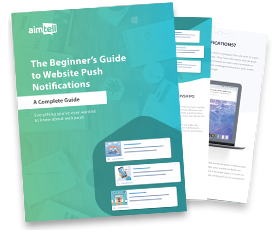Dealing with cart abandonment is inevitable when it comes to the world of ecommerce, but that doesn’t mean there isn’t anything you can do about it. In fact, there is plenty you can (and should be) doing to try and earn back some of those sales you were so close to attaining.
How so? By sending the right web push campaign! Web push is one of the best ways to reduce cart abandonment, as your message is sure to be seen by your audience. No more getting lost in a crowded inbox or social feed. And no more losing track of a customer who didn’t provide their contact info!
Need some inspiration for your cart abandonment campaign? You’ve come to the right place. Here are 8 great notification ideas along with real-life examples from some of our great Aimtell clients. Use these templates at your own store and watch your cart abandonment rate fall!
Why Consumers Abandon Their Carts
Before we dive into ways you can reclaim your abandoned carts, we wanted to discuss some of the main reasons why users abandon their carts in the first place. By overcoming some of these initial hurdles you can work to lower your overall abandoned cart rate. While there is no way to get that rate down to zero (and that’s why retargeting is so important) even a small decrease in abandoned carts can amount to a nice boost in sales and customer satisfaction.
Shipping Costs
While it is true that nobody likes paying for shipping, and in fact, research shows that more than 60% of customers at least consider abandoning their order because shipping isn’t free, a larger problem exists when you don’t disclose the cost of your shipping. It should go without saying that any sort of hidden fee is not going to make a customer happy, and this happens all too frequently when it comes to shipping charges.
The easy fix to this problem is to simply make it known what you charge for shipping. Do not wait until the final moment to add in the shipping fee. If your shipping varies based on certain factors, consider implementing a feature on your website that allows a user to calculate shipping in advance depending on where they live or what they are ordering. If you use WordPress and WooCommerce, for example, you can install the Flexible Shipping plugin to handle all of this information for you.
Also, consider offering free shipping when you are able to. You may choose to make domestic shipping free, offer free shipping if a customer spends a certain amount of money, or even include it as a perk to joining your rewards program (if you have one). You don’t have to make shipping free 100% of the time, but you should strongly consider offering it in certain scenarios in order to make your customers happy. The added value in the long run of gaining more customers outweighs the shipping costs you have to cover.
Long Checkout Process
Once a customer does make the decision to purchase something from your website, they want the process to be as quick and painless as possible. A long, detailed checkout process is a really easy way to turn customers away. Customers will only be understanding to a certain extent when providing their information. If you include a bunch of extra steps, you risk losing a lot of orders.
Customers are also very wary these days of how companies use the information they provide. Fears of their email or phone number ending up on spam lists is a major concern, leading some customers to refrain from ordering if they are required to provide a bunch of additional information for seemingly no reason.
It is fine, and in fact necessary, to request information from customers when they are placing an order. However, be sure to include a notice that the information a user provides is kept confidential and will not be used or sold to another company.
Keep your checkout process short, and give users the option to checkout as a guest if they are not already a member. The additional steps to sign up for your website may deter some users. If possible, consider implementing a “quick purchase” option that allows a user to store their payment info so that during future purchases they can quickly go through the checkout process. This is incredibly convenient for users and helps encourage repeat purchases. And as you know, customer loyalty is crucial for success.
Absence of Site Security
Customers are not just wary about giving out information, they are also wary about overall site security. People are very aware of the dangers of hackers stealing credit card and other important info and will not make a purchase on a website they feel is not safe. This is especially true for smaller ecommerce businesses.
Installing an SSL certificate is the best way to make your website more secure. Without this secure connection, your business will seriously suffer. Not only will customers not trust your site, you can also suffer in terms of SEO value. Right now, Google lists HTTPS as a light ranking signal, but you can easily expect the signal to increase in importance as more and more sites make the switch.
Note: For you web push users out there, you also need to be using HTTPS in order to send notifications to just about any browser, with the one exception being Safari.
8 Free Push Notification Templates to Reduce Cart Abandonment
1. Sale Announcement
If price is what is keeping your customers away, announcing a new sale is a great way to draw them in. This is a quick and easy way to see an increase in traffic to your site without having to do a lot of extra work. You were already planning the sale anyways, so advertising it is a natural step to take that will certainly pay off.

2. Buy One Get One
If you want to get rid of a lot of inventory, a BOGO sale is a great way to do so, and it’s something that customers love. If a customer has already committed to purchasing with you, it is likely they will pay a little more in order to get an additional item.
Alternatively, if they were undecided about who to shop with, seeing that they can get two items for either the price of one, or a little more than the price of one, can be the determining factor they need to shop with you.

3. Free Shipping
We already mentioned this as a reason why users abandon their carts, so consider advertising it as a way for them to complete their purchases! Combine this with another tactic such as urgency (24 hours only!) and you’ll see a nice boost in sales.

4. Cross-Sell/UpSell
Entice your customers to come back and finish their order by giving them an exclusive offer that is relevant to their purchase. This is a great opportunity to cross-sell other items that they are likely to want to use with the item they were already thinking about purchasing.
Combine the cross-sell opportunity with a discount and you have a great campaign that will certainly recover a lot of your abandoned carts.

5. Low Stock Notification
Nobody likes missing out on a great deal or great event. Instilling that fear of missing out on something is a great way to recapture your customers and have them complete their orders. The FOMO is real, but it doesn’t have to be! Alert your customers that the item they are interested in is either low in stock, or being held in their cart for only a brief time.
This FOMO tactic, which also creates a sense of urgency, creates a really powerful call to action. You don’t want to miss out on that great deal, do you? Of course you don’t!

6. Countdown Sale
Build up some excitement around an upcoming sale by starting a countdown and alerting your subscribers. This is a great way to refresh the memory of your subscribers and alert them of a great sale you will be running.
Sometimes a user abandons their cart and simply forgets about it. By counting down to a great sale you are reminding them of what they left behind and also enticing them to come back by running a great sale.

7. Supportive Messaging
Everyone loves a little praise now and then. It’s in our nature. Play into that by crafting campaigns that focus on positive emotion and also on complimenting a customer’s choices. The positive reinforcement can help convince them that purchasing the item is the right thing to do.
Sometimes all it takes is a little push to help a customer convert, and that is exactly what this type of campaign accomplishes. Consider also personalizing the campaign by including the subscriber’s name to really drive home the message.

8. Align Purchase Intent
How will the product a customer is shopping for improve their life? Consider the benefits of a particular product and use that to help close the sale.
After all, most customers shop for items to relieve a certain pain point they have. Whether that is needing a better wardrobe or getting a better night’s sleep, reminding them that your product will help them achieve that is a great way to convince them to return to your site and finish their purchase.

9. [Bonus] Funnel Abandonment
Did you know you can now track and retarget subscribers who abandon a funnel campaign of yours? This is great for users who look at products but don’t commit to adding them to their shopping cart. You can still go after that sale!
Target subscribers who abandon a certain product page or category to remind them of your brand. This alone may be enough to bring them back, or you can add in a discount code to help sweeten the deal.

Wrapping Up
These are some of the best tactics to employ when trying to reduce cart abandonment. By offering a discount, creating a sense of urgency, instilling FOMO, being supportive, and more, you can easily reclaim some of your abandoned carts. Better yet, by also tackling some of the initial reasons why your customers are abandoning their carts to begin with, you can be sure to see a solid increase in conversions.
Which cart abandonment tactic is your favorite? Is it something we didn’t mention here? Let us know and send us a message!
If you are new to Aimtell, you can get started for free or learn more by reading our Beginner’s Guide.
GET STARTED FREE
Tags:
abandoned carts, cart abandonment*, digital marketing, ecommerce, web push, web push notifications.


































